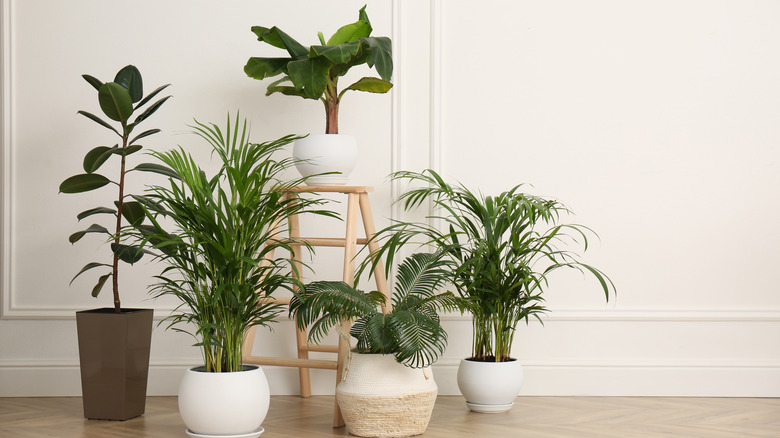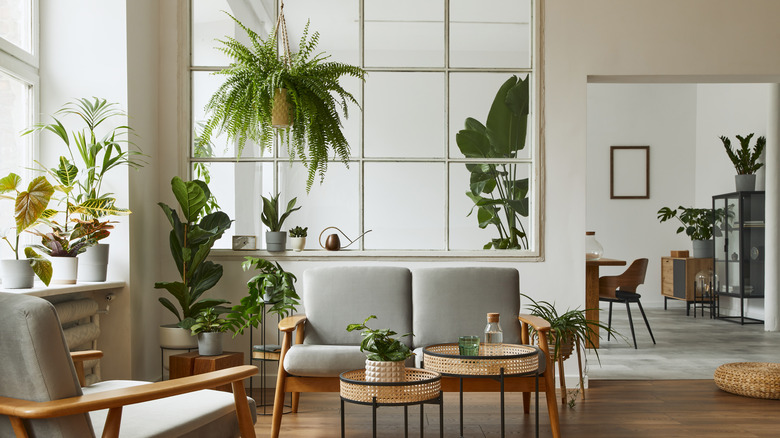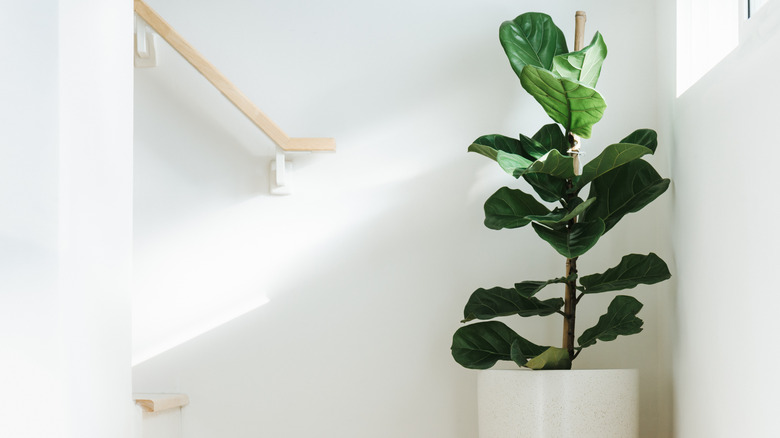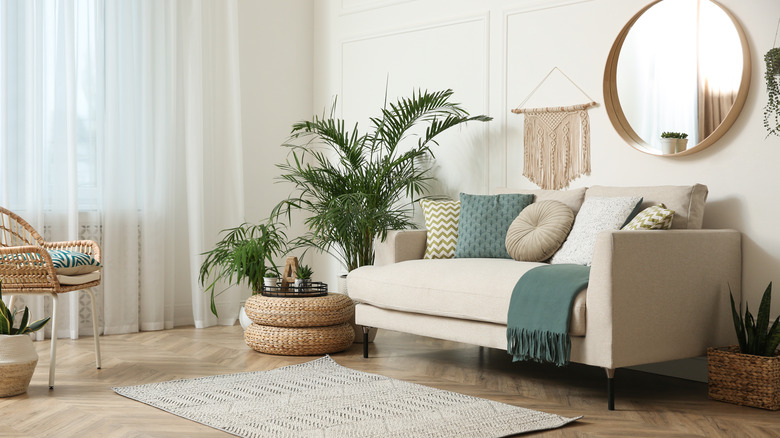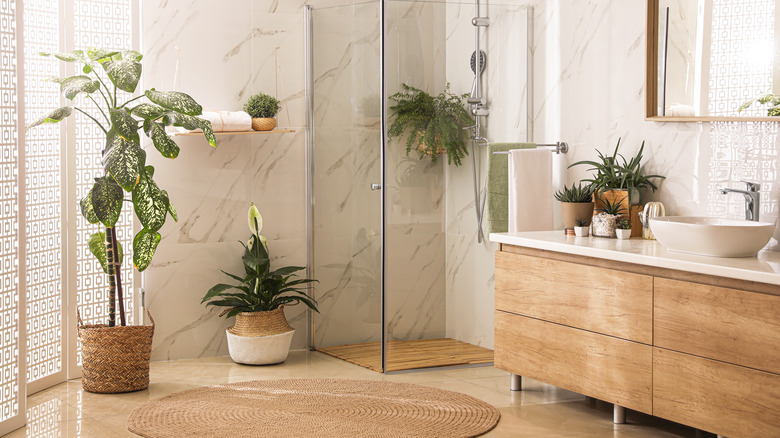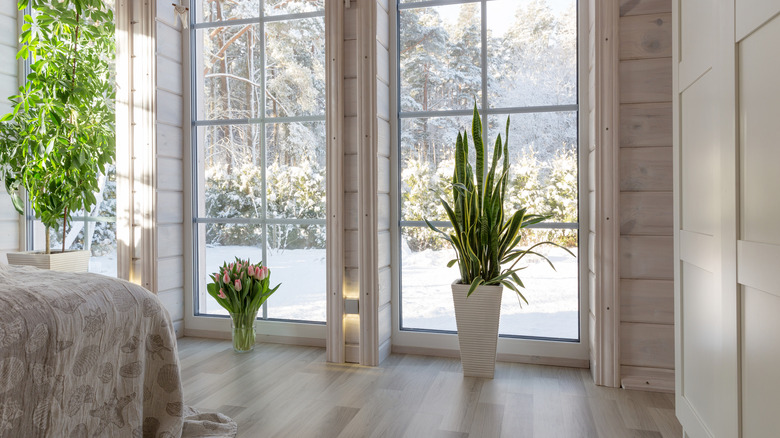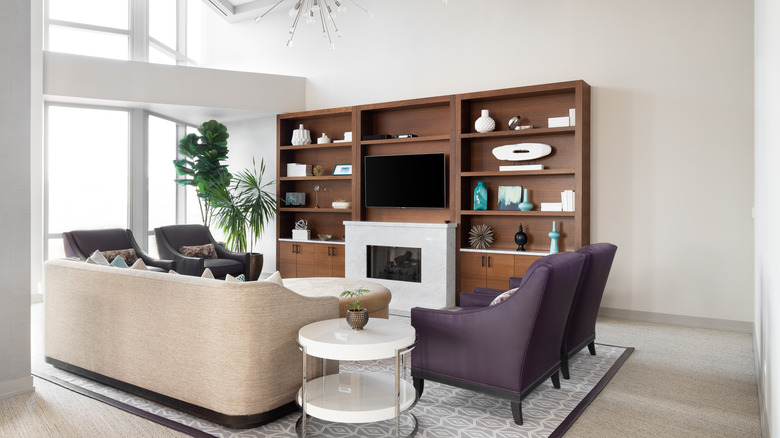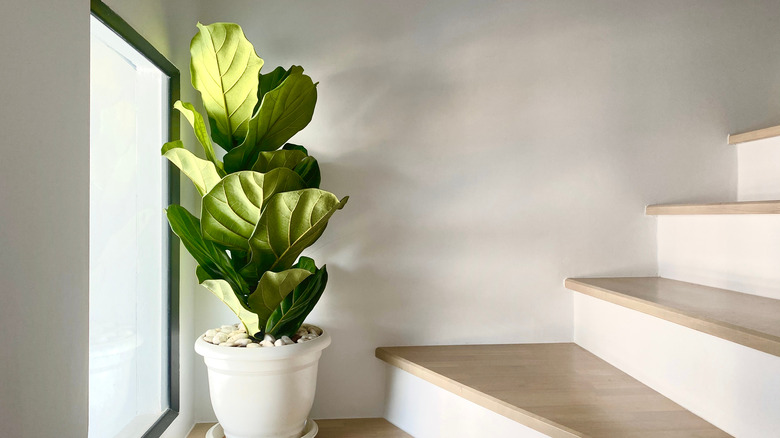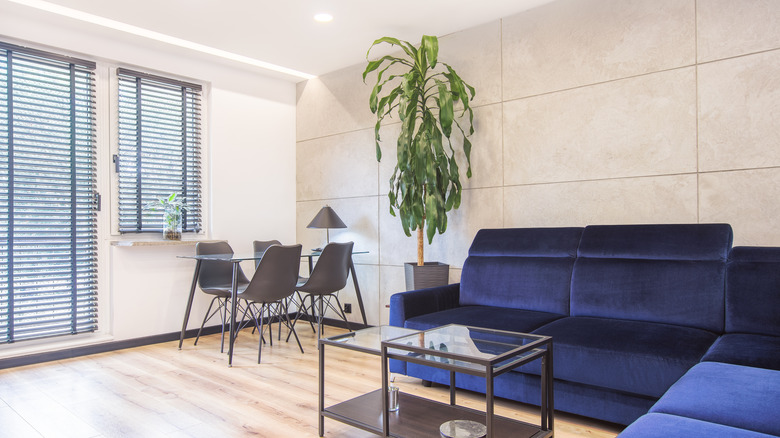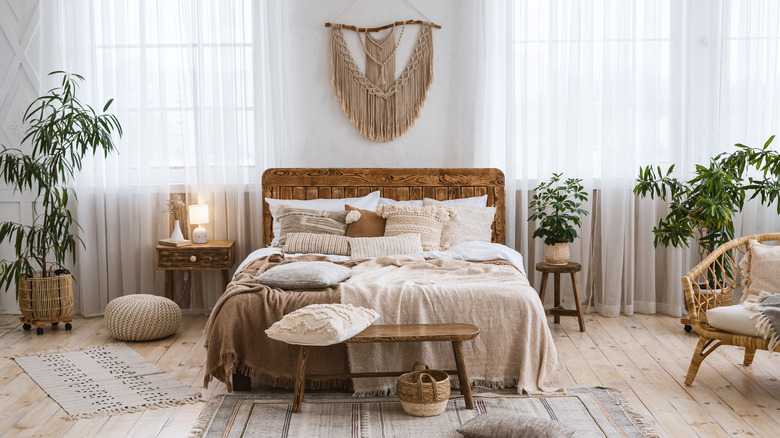How To Pick The Right Indoor Tree For Your Home
Houseplants are popular in any style home but how do you know which ones to buy? What type of care do they need? How do you set them out in a way that is worthy of a social media post? Whether you are a plant novice or jungle expert, decorating with indoor trees is a must-have feature to have in a home. These vertical house accessories can help define space and add visual interest in any interior design preference. You may already have some or perhaps you are a decorator who is just beginning, either way, we have put together a guide to help you pick the right indoor tree for your home. Don't worry, we even have a few plant options for those who have more of a brown thumb than a green one. Just keep scrolling, we have plenty of tips to help you choose!
One of the simplest ways to fill a home is with organic features. "Always embrace plants to add a natural element to your space," Caroline Grant, a New York-based designer, told Popsugar. "They bring life into the space and instantly add an airy organic feel to the room. They don't take up too much room as they come in different shapes and sizes, and they're relatively inexpensive. Add your favorite plants to your counter tops, empty corners, and bookshelves to create design interest amongst your space." Always do your research when picking plants, otherwise you may end up with too many neglected ones later on. Jot down a few of the tips below when picking indoor trees for your home.
Think about the room
If you're like most people you more than likely would pick a plant based strictly on how it looks. Let us stop you right there. Try your best not to get all wrapped up in the color, shape, and size of the tree just yet. If we may suggest, do not purchase a houseplant based only on how pretty the leaves are. A plant is only as pretty as the room you put it in. The plant's environment will directly impact the greenery. Therefore, selecting a room is the first step to decorating with indoor trees – before the tree itself! Any room of the house is suitable for an indoor plant from the living areas, and bathrooms, to the bedrooms. With one minor caveat in the way. What are the conditions like in the room?
Before finalizing the plant's placement in the space, first, consider the room the plant will be spending most of its time in. Is the area hot, cold, sunny, or shady? The room conditions will likely determine the type of plant that can thrive in the space. Most indoor plants like warm conditions, as they are originally found in tropical and subtropical environments (via Gardeningetc.). If you have a room that receives a copious amount of sunlight, put a tree in there.
For those with cooler spaces, not all plant species require the same amount of sunlight or heat index with several options available to choose from. Some plants are able to tolerate lower amounts like a rubber tree or lady palm (via The Family Homestead). Other room conditions to consider are the wall space and how much of it the plant will be covering, as well as any doorways, windows, art, and furniture. So before you buy a plant based solely on looks, it's best to determine where it's going and then choose a plant afterward.
Choose a corner with sufficient light
With the focus still on the room and its conditions, there is one more structural aspect to take into account when decorating with indoor trees. What direction the windows face is important to the type of plant you bring home. North, south, east, west? Which way do the windows in your own house point toward? The answer will likely determine how much (if any) sunlight the tree you are decorating with receives, especially if you plan to place a plant in the corner of the room.
Most varieties of indoor trees can do well in moderate levels of indoor lighting. Just try to choose a corner that is opposite or near a window for maximum light exposure. After all, it's unlikely you will be moving a large indoor tree routinely to another area if the room you really want the plant to be in is lacking in daylight. Be realistic about your commitment, the plant, and its placement.
We won't leave you out on a limb here. Foliage that requires sunlight for a few hours a day should be near an east or west-facing window. This placement and window directionality allows the plants to escape the hottest part of the day but receive the max amount of daylight. Other tree species that require less sunlight can be placed in front of or close to a window that faces north, while plants that need full sun will do well in a south-facing window (via House Plant Expert). If you desperately need a plant that can survive in the dark, try to choose from plant species that can tolerate the lack of light, such as a corn plant, lady palm, or dragon tree (via House Plant Help).
How good is your green thumb?
Choosing an indoor tree for your home is as much about you as it is about the room or anything else. Believe it or not, you actually factor in quite a bit to how well the tree will do once it moves in. You are the main caregiver of whichever tall indoor tree you choose for your place. You are its light source, water giver, and overall plant parent. Don't let this stop you from decorating with indoor trees — just be ready for all the giving it needs!
New and experienced plant parents have had a plant or several not make it. "Trust me, there's somebody out there killing the same thing as you," Melinda Myers, author and horticulturist, told Real Simple. "There are the over-waterers, who kill a plant with kindness, or the ones who can never remember. The difficulty is matching the plant to the person who will take care of it." How do you ensure your plant makes it? By matching it to what type of plant parent you are. (Be honest). Try to pick plants based on personal characteristics like your schedule, availability, and personality. Be realistic about what plants you can maintain and your personal level of commitment to caring for it.
Low maintenance verse high maintenance plants
We discussed what type of plant parents there are but not what type of plants are best for them. Once you have determined which type of plant parent you are going to be, it's time to consider the level of care the plant you pick is going to need. The best plants are matched to their owners as you now know. For those who are up for a challenge, there are high-maintenance trees such as fiddle leaf figs, weeping figs, and Boston ferns that you may include in your home. These indoor trees require a bit more attention, benefiting best from an established watering routine, frequent dusting, and the right amount of sunlight branch to branch. If you thrive on routine and don't travel much, choose a high-maintenance plant to grow with you.
If less is more, consider some indoor plants that are less demanding on you and your schedule. There are several types of indoor trees that require much less attention. Deck out your space in foliage that's as relaxed as you are. Consider adding indoor plants such as palm trees, cornstalk dracaena, and Monstera deliciosa (via Homes to Love). These leafy greens can survive if you skip a watering day or two and some can do surprisingly well under low lighting conditions. If you decorate your space with plants that are both high and low maintenance, try grouping them in the same room so you can keep a rhythm of care that's less hectic for you.
Pick plants based on the season
How each indoor plant you purchase for your place is cared for is important to its survival but sometimes mother nature beats out the best care. As the seasons naturally change outside, so do the plants, even indoor trees can be affected by the changes in the weather. This could be good or bad for the plants you choose to decorate with in your home. The time of the year could possibly determine if the plant will thrive inside.
You can certainly purchase plants any time of the year if you wanted but they may not do as well as you expect them to. All plants are natural sunbathers that prefer hotter temperatures, so naturally, winter months may be the time of year to pause the addition of any new plants at home. The colder temperatures typically bring cooler, drier air, not necessarily the most accommodating conditions for most plants. According to Plant Care for Beginners, it is ideal to purchase greenery in the spring and summer as these warmer months give it the best chance of surviving, even indoors. Some trees such as banana plants, monsteras, birds of paradise, or a money tree could be perfect houseplants to buy when the temperatures are warmer outside. One or two of these indoor trees will surely spruce up the decor in any house or apartment.
Pick one with a unique leaf shape
We have shared the top tips on how to keep a tree thriving indoors. Since maintenance is out of the way, we can finally move on to picking a plant purely based on how it looks. Decorating with greenery is naturally beautiful because of the interesting forms the plants and trees are able to take on. Use the organic features as a natural decorative advantage when selecting indoor trees for your dwelling.
Some tall trees have large glossy leaves and interesting growth patterns, colors, or shapes. These peculiarities can be the visual stimulation your jungle landscape needs. Use a plant's distinct features to decorate your home the same way you would select a portrait or piece of art for its brushstrokes or design. Concentrate on the elements that make the plant unique. The plant's leaves are one way to distinguish a plant species from another and add character to a home. A plant such as a fishtail palm is, as the name suggests, named after its leaf shape which resembles a fishtail. These indoor plants are ideal in a bathroom as they prefer a higher humidity level compared to other plant species. However, this palm plant despises soggy soil — overwaters beware (via Smart Garden Home). Other leaf shapes could be rounded, pointy, or oval. You can even find plants that have been trained to have braided trunks (via The Healthy House Plant). Use the different leaf shapes and trunk styles of indoor trees as a way of introducing movement and dimension into your place.
Choose a statement tree
If you really want a dramatic reaction from onlookers, pick a tree that makes a statement by just filling up all the space in a corner. Choose a tall indoor tree not just for the shape of its leaves but its size and presence when placed in any room of the house. Which tree is this? You have probably heard of it before. Decorate your place with a fiddle leaf fig tree. These trees are typically tall with large leaves branching off in many directions as seen in the image above.
Due to its size and physical appearance, a fiddle leaf fig tree is perfect for taking up negative space in a room and anchoring a design. "It adds an architectural addition to a living space," Thomas Broom-Hughes, the Horticulture director at Petersham Nurseries, told Livingetc. "A bright bathroom would be an ideal indoor location, or a living room would also work if you can give it enough humidity." These trees can be known to be tricky plants to care for. According to Stump Plants, fiddle leaf figs need direct placement in front of a window and a consistent watering schedule. Aside from plenty of sun and just enough water, the fiddle leaf fig tree needs regular dusting as its broad leaves can collect a good amount of dust just like any other flat surface. You may also want to rotate the plant often to ensure the leaves and branches grow properly. Fiddle leaf figs seem to pop up all over social media platforms. According to Kathy Kuo Home, the reason is simply because they are photogenic. If you can keep up with the upkeep then you're definitely going to want to consider adding this photo-ready indoor tree to a corner of the room in your house.
Tall plants can help fill voids
Do you need to fill a corner? Occupy an awkward space in the hallway? Fill a gap next to the fireplace? Then you need a tall tree that can take up as much space as possible without overwhelming the area it's in. The best trees for spaces like these are those that have an abundance of leaves to cover up as much open space as possible. They don't need to be large but there needs to be a lot of them! Indoor trees with plenty of leaves need to have lots of branches. This is what you're looking for in an indoor tree to help you fill in voids around your home.
Yes, all trees have leaves but not all of them produce the same amount or are layered in the same way. For the best coverage choose indoor trees that grow a dense amount of leaves on their branches. Consider potting a natal mahogany tree that has "big and bushy dark green leaves that can fill a void," Tara Heibel, owner of Sprout Home, told Architectural Digest. "It will provide that lush summery depth that you might be searching for." The thin branches of this tall indoor tree reach out sort of like a palm tree would but at different heights and directions providing plenty of coverage. It's best known for its deep green color leaves. A natal mahogany's height and closely grouped feather shaped leaves make it a perfect indoor tree for filling up the right amount of space (via Dengarden).
Consider who lives in the house
Decorating with greenery indoors can add a lush, luxurious, peaceful feel to a room. But indoor plants could also be dangerous to some people if those who live around them are unaware of the plant's potential hazards. One aspect many decorators may overlook when picking the perfect indoor tree to complement the interior is how well it will interact with those who live in the house already, especially kids and pets. Consider those who reside there already and whoever may visit you at home. If you have concerns about the types of plants that could cause reactions, it may be wise to use the ASPCA's database on toxic and non-toxic types of plants before placing a plant inside your home. Consider what interactions and reactions certain plants can cause in humans and animals.
Decorating with indoor trees is more than meets the eye, isn't it? Don't be frightened off by the maintenance, watering schedules, amount of sunlight, or what season it may be for purchasing different types of plants. All these tips shared are for you to incorporate so you and your plant can thrive and live your best lives together. We hope by the end of this article, you are a little less overwhelmed and can decorate with and grow plants in your home with confidence. Bring your home to life with greenery using some of these suggestions for how to pick the right indoor tree to complement any room.
